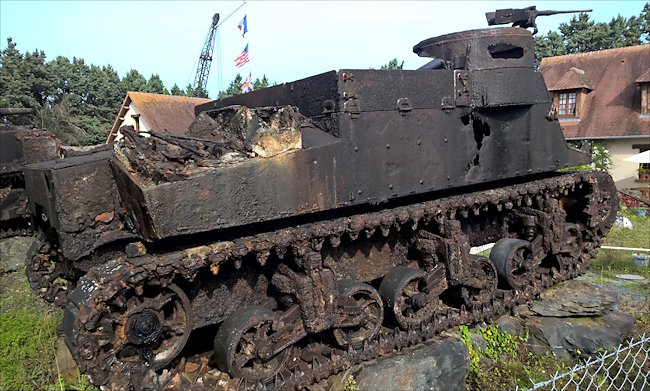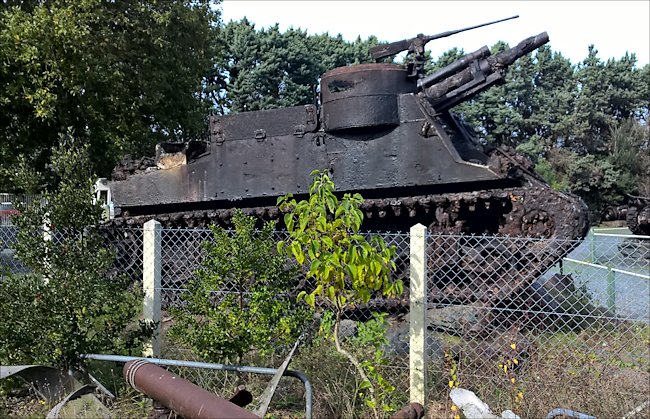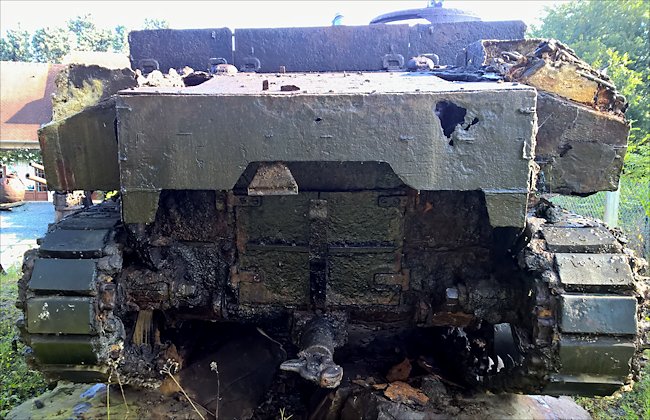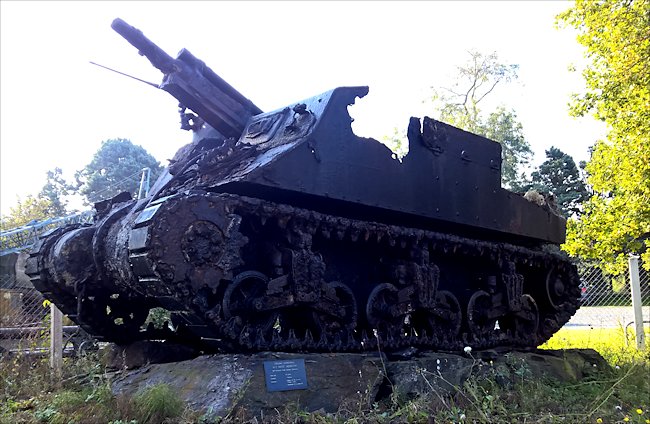Port-en-Bassin M7 Priest underwater wreck
By August 1944 most British 105mm M7 Priests had been replaced by 25pdr Sexton self-propelled artillery guns. The main reason was the problems of supply of American ammunition. The British and Canadian units attacking Gold, Juno and Sword Beaches used M7 Priests. The US Army also used M7 Priests to supply mobile artillery support on Utah and Omaha Beach.

M7 Priest wreck in the Musee des Epaves sous Marine du Debarquement
Location
This is the D-Day wrecks museum. It is situated on the D6 road from Bayeux to the charming Normandy costal village of Port-en-Bessin-Huppain. It is on the right as you pass the sign for the Chateaux La Cheneviere restaurant.
The complex grounds are screened by a wall of tall evergreen trees. Sticking above the tree tops is a crane and normally three flags; the French tricolour, British Union Jack and American Stars and stripes. Slow your car down as you pass the Chateaux as the museum entrance is very quickly upon you.
The Museum is open every day between 1st June to the 30th September 10am to 1pm closed for lunch and then open again 2pm to 7pm. In May it is only open at the weekend. From 1st October to the end of April it is closed.
Specification
The M7 Priest was powered by a Continental R-975 C-1 petrol engine which produced 400 hp. It had a top road speed of 24mph (39 km/h) but only 15mph (24 km/h) off road. Its armour thickness ranged from 12mm to 62 mm. The M7 was not designed to be at the front of a battlefield battling tanks. Its armour was only thick enough to protect the crew from small arms fire and shrapnel from exploding enemy rocket, mortar and artillery fire.
Its main gun was a 105 mm howitzer that could fire high explosive HE shells 7 miles (11.27 km). As you can see from the photograph below the M7 Priest was also fitted with a 0.50 inch (12.7mm) M2 Browning Machine gun in the pulpit. The Priest could carry 69 shells. Some of these would be smoke rounds and a few armour piercing rounds for close protection if they were surprised by an enemy tank.

A M2 Browning Machine gun was fitted to the 'pulpit' to provide self defence capability.
Deployment in Normandy 1944
It was found that towed artillery guns could not keep up with fast moving tank columns over rough ground. They also took time to set up. The answer was to mount artillery guns on tank chassis'. Although the Priest carried some armour piercing AP rounds just incase they were attacked at close range by German tanks, the majority of the shells it carried were high explosive HE artillery rounds. Crews also carried a few smoke shells.
It was called the 105 mm Howitzer Motor Carriage M7 in the US army. It was used by the British Army under the lend lease agreement in the North African desert, Sicily and Italian campaigns. It was officially called the 105 mm Self Propelled Gun, Priest. The previous British SPGs had been called the Bishop and Deacon. The M7 had a pulpit like machine gun armoured tower. This is why it was given the nickname, 'The Priest'.

The engine was at the back of the vehicle
Most British M7 Priests that were replaced by Sexton 25 pdr Self-propelled Artillery guns were not given to the Americans to use. They were turned into armoured personnel carriers. Their guns were removed, additional armour plating was welded to the front screen where the gun mount had been. At first they were called 'defrocked-priests' but later the name 'Kangaroo' became more popular with the troops. They played a big role in the break out from Caen in Operation Totalize.
A plaque by the M7 underwater wreck at the Musee des Epaves sous marines du Debarquement reads, 'M7 Priest Howitzer from the 58th Armored Field Artillery Battalion, recovered from a landing craft LCT wrecked 3 miles from Omaha beach carrying two jeeps, three half-tracks and four M7 Priests. Inside the vehicle was found documents that enabled the identification of the driver John H. Glass and the reconstruction of its incredible journey from North Africa to the Normandy Landings.'

The M7 Priest was damaged when it sank to the bottom of the sea
Development of the M7 105mm Priest
US Army plans for mounting a 105mm howitzer on the chassis of the M3 medium tank to provide self-propelled artillery support for armoured divisions were made in June 1941 as soon as the M3 Lee was in production. Two pilot models were constructed, designated T32, based on M3 Lee medium tank chassis, but with an open topped superstructure.
The standard MIA2 105mm howitzer was installed with its carriage suitably modified to fit. The weapon was offset to the right of centre. The trials vehicles were successful and the design was standardised as the M7 HMC in February 1942. Changes (made in the T32) for production vehicles included modified front shields and a cupola and ring for an AA machine gun.
American Loco started production in April and built 2028 in 1942. Late production vehicles had M4 type bogies with trailing return rollers; otherwise the M7 had identical chassis and mechanical specification to the M3 medium tank. A few late production M7s also had a one-piece cast nose instead of the original three-piece bolted type.
Meanwhile the M4 Sherman Tank had superseded the M3 Lee Tank in production and in September 1943 it was proposed to continue M7 production on the chassis of the M4A3 medium tank. Designated M7B1, this vehicle differed from the M7 (aside from its different power plant) in having hinged side plates for added ammunition protection, a cast one-piece nose, and bogies with trailing return rollers.
Pressed Steel Corporation built 826 from March 1944-February 1945, after which Federal Welder built another 127 vehicles of both M7 and M7Bl type by the war's end. With the standardisation of the M37 HMC on the Light Combat Team (M24) chassis in January 1945, the M7 and M7B1 were reclassified to 'substitute standard' and were gradually replaced by the M37 from then on. The M7 and M7B1 HMCs were standard equipment of artillery battalions in all American armoured divisions.
The M7 Priest had a very light gun for such a large chassis, but the M 7 series were an expedient type got quickly into service and enjoying the advantages of standardisation and reliability inherent in the M3/M4 medium chassis. Proved very successful in service though crew protection was limited but still better than for the crew of a towed artillery gun.
The M7 Priest in British Army Service
n March 1942 The British Tank Mission in the United States saw the M 7 pilot model and immediately requested 2,500 for British use for the end of 1942 with a further 3,000 for delivery in 1943. These demands were never met in full owing to the need to equip American forces first.
Due to the serious position of the 8th Army in the Western Desert in September 1942, however, 90 M7s were sent to the British, diverted from production intended for American troops. They arrived in time to play an important part in the crucial Alamein battle and several hundred more vehicles were sent in the following months. They remained in service with 8th Army throughout the Italian campaign.
In British service the M7 was designated '105mm SP, Priest'. Priests also equipped some of the artillery battalions with British armoured divisions in the Normandy landings, June 1944, but these were replaced by Sextons a few days after landing, partly in order to standardise ammunition in 21 Army Group and partly to make more 105mm ammunition available to the American forces.
D-Day 1944 books

